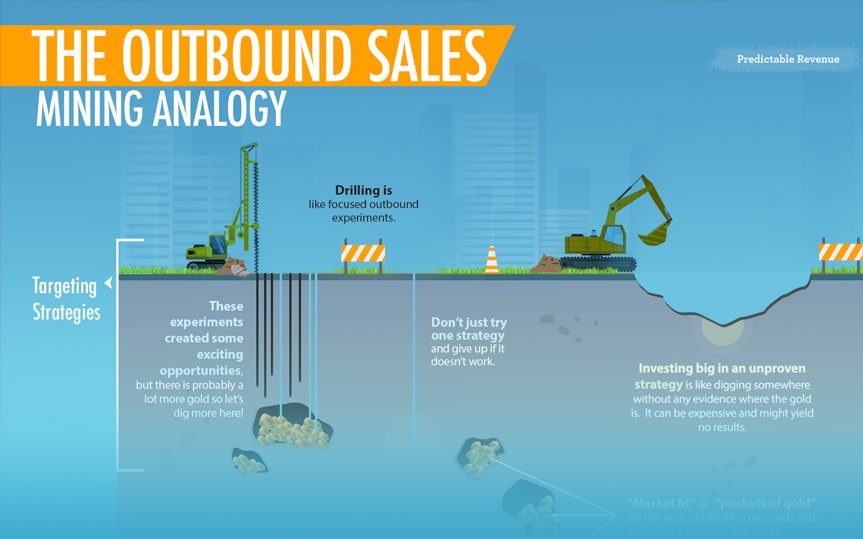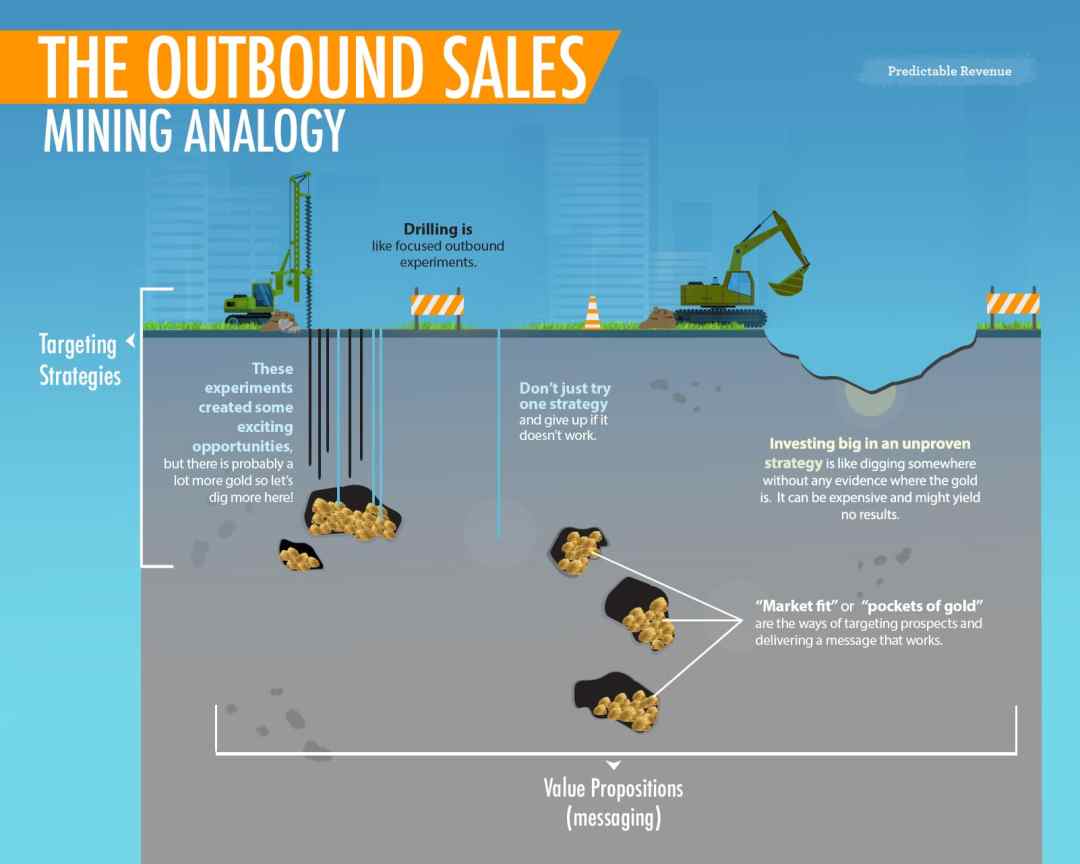Cost vs Yield in Outbound Sales Might Be the Most Important Concept You’re Missing

Author: kenny mackenzie
This article is for Sales Leaders for B2B offerings with an average first year contract value between $10k and $1M, who want to smash their sales goals with Outbound Sales Development.
Outbound Sales has evolved a lot in recent years and deciding how to invest in it has become increasingly complex. What was once an industry of faceless call centers cold-calling prospects during business hours, has now become a mix of 24/7 email, cold-calling, social media outreach, texting, direct mail, targeted pay-per-click ads, the list goes on…
Of course, these different strategies come at different costs, but spending more on outbound doesn’t necessarily guarantee more results. This article aims to show how you can improve your yield (booked meetings, closed deals) over time by running quick experiments and optimizing what works.
Long gone are the days where you could pull out a phone book, start dialing and expect to get significant results. Similarly, building a list of 3000 prospects in line with your Ideal Customer Profile and blasting them all with the same email template just doesn’t work like it used to. Decades of “one-size fits all” high volume outbound activities have made us all wary and extremely critical of unsolicited outreach.
In sharp contrast to the “one size fits all” high volume approach is a heavily researched and personalized 1:1 approach executed across multiple channels – figuring out precisely who needs your offering, why they need it, and then reaching out via email, LinkedIn and over the phone with a clear reason why you think you can help them. Often, when prospects receive this type of outreach they aren’t bothered at all, they actually appreciate it. The key is to present them with what they want when they want it – what we at Predictable Revenue call “nailing relevance”, (a key first step in Nailing a Niche).
But, as every sales leader will tell you, heavy personalization and a multi-channel strategy in your outreach takes a lot more time and comes at an increased cost upfront (and can include some deadly hidden costs to the inexperienced). It can absolutely yield better results, but only with a deep understanding of your customers and what matters to them. Despite that increased investment, when your understanding of your customers and the relevance of your offering is vague, a higher-cost approach most likely won’t result in more booked meetings.
To recap: on one end of the spectrum you have a very low cost (per prospect) outreach strategy that yields poor results, and at the other end, a very high cost (per prospect) outreach strategy that only yields good results when you are connecting with people who have a relevant need.
These two examples describe the two ends of the spectrum of the Cost vs Yield equation in Outbound Sales. As you read this article I hope to convince you of when to deploy a low-cost low-yield strategy to learn, and when to deploy a high-cost high-yield strategy to drive results (booked meetings and closed deals).
The Mining Analogy
Imagine you are a gold mining company that wants to open a new gold mine. The first step is to find some gold to dig up, and a good start to that will be to survey the surface of an area of land where you think there may be some gold deposits. This is a bit like doing some Google searches about your market – you are just barely skimming the surface.
The next step in mining might be to drill into the earth and start pulling ore samples. Usually mining exploration companies drill in a grid-style pattern around the area they most suspect the gold to be. Drilling is cheaper than digging, but it isn’t free, so a company may drill 40 times. You will gain a lot more confidence if there is gold down there and begin getting insight into where exactly it is, but drilling isn’t very effective at actually extracting the gold.
Now, imagine a couple of those drill samples have some gold in them, not a lot of gold, but enough to tell you that there is a vein down there. Once you know there is gold and you have a lot more accurate understanding of where it is, you can start to set up your mine and get digging.

Let’s consider how this compares to developing your first outbound strategy.
First off, you need to have a product or service that people actually need (the gold has to actually exist!). The best way to build confidence in your market is usually to do discovery interviews with relevant people in your network, existing customers and/or inbound leads.
Once you know some gold is there, you want to figure out exactly where it is and how to get it. Drilling 40 times in a grid would be like designing 40 different email campaigns tightly focused on specific groups of customers and thoughtfully relevant value props. And discovering a bit of gold in a drill sample is a lot like having one of those email campaign experiments generate a few leads.
And knowing where to dig to find more gold is a lot like having proof that a specific group of customers likes a specific way you can frame your value to them. Once you have this evidence, you can invest into going after that group more aggressively, with more confidence that yield will increase proportionally with your investment.
The biggest difference between mining and outbound sales is that in mining the ore doesn’t move around on you, but in outbound sales, markets change. The market fit that led to customers signing up a couple of years ago may not be effective anymore, and it’s up to you to adjust accordingly.
When To Use a Low-Cost Low-Yield Strategy
The Short Answer
When your understanding of your market fit is vague, or your confidence is low: use it to experiment systematically.
The Long Answer
In 2019, when comparing commonly used b2b outbound channels such as email, calling, and Linkedin, email tends to have the lowest conversion rates but is by far the cheapest to do at scale. This really benefits rapid experimentation with meaningful sample sizes. If your understanding of your potential market is vague, channels like email are a great way to quickly test many different hyper-focused niche campaigns. Even the best results of these campaigns may not be great, but when you benchmark them against the baseline it can be the fastest way to separate effective ideas from the ones that just don’t work.
Now, imagine you run 20 different email campaigns that test 4-5 different persona-specific messages on 4-5 different market segments. Maybe 16 of those campaigns come up with big zeros, while two of them convert around 0.2%, and one converts at 0.5%, and another at 1%.
A 1% conversion rate may not sound great, but when you compare it to the other experiments and broader cold-email conversion benchmarks, it is a signal that it’s worthwhile to invest more in that specific targeting and messaging approach (you just found some gold, so get digging).
Another benefit of using a low-cost low-yield outreach strategy is that you can survey a ton of people cost effectively. If you shift the focus of your outreach from trying to get people on a call to asking probing questions about their business and the relevance of your offering, you can learn about the differences between industry segments or personas at scale, and that may be very relevant to how you sell later and can even help inform your product roadmap in a statistically significant way.
In other words, a good first step to take in outbound sales development is a blend of:
- Focus on nailing “relevance” (targeting and messaging) before worrying about channels or process.
- Blend sales development activities with a market research attitude to learn fast.
- Leverage the scientific method: build hypothesis, design experiments to test them, and validate your theory.
As your understanding of which people in the market to focus on and what to say to them improves, you can transition to higher-cost higher-yield outbound strategies to maximize market penetration.
Account Based – Higher Cost, Higher Yield
Account Based Marketing, or Account Based Sales Development, is how most people in the industry today describe a high cost high yield strategy. As mentioned above, it requires a high degree of confidence in exactly which companies need your solution and a moderate amount of confidence in which people in those companies are responsible for the problem you solve.
You can always guess at these things, but without any hard evidence you may waste a lot of time and money pursuing the wrong account list and the wrong personas with the wrong message. Breaking down your market fit theory into individual hypotheses (our offering is relevant to this person for this reason, or that person for that reason) and testing them at scale remove a lot of the risk from this investment.
Once you have proof a certain market segment and messaging combination converts better than others, you can start to optimize against it with an Account Based strategy. This could include:
- Being very deliberate about which companies you reach out to
- Spending more time researching each prospect before you reach out to them
- Hand-crafting personalized one-off messages to each prospect
- Layering on more channels to your outreach strategy
Utilizing more channels in your outreach will increase your conversion rate, but only if you have a conversion rate to increase. You have to nail relevance (right people, right message) before you can improve results with more channels or better personalization. For example, imagine that LinkedIn will convert 3 times better than email. If your email conversion rate is 1%, maybe LinkedIn will convert somewhere around 3% using the same targeting and a very similar messaging strategy. However, if your email conversion rate is zero, LinkedIn will still convert at zero. Zero multiplied by whatever is still zero.
This is why it makes sense to start with lower-cost rapid experimentation until you figure out which targets and messaging works together, then transition to higher cost-per-prospect strategy once you have it figured out.
How We Do It
These days when companies with limited outbound experience come to Predictable Revenue for help finding their customers, we often start with what we call Outbound Validation. That process involves market fit workshopping and many experimental campaigns with strategically focused prospect targeting and copywriting. The goal is to learn as much as we can from the market very quickly to learn what works and what doesn’t. (As many as 40 campaigns in 3 months)
As our collective understanding of their market fit improves, together we transition to gradually higher-cost higher-yield activities. In the final stages of our services we do deep research, heavy personalization, and use multiple channels with a dedicated multi-function sales development team, which we either coach our clients to build or build for them.
